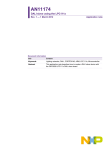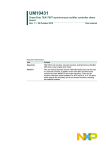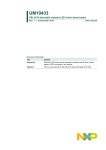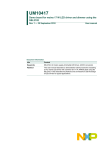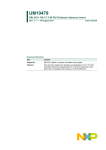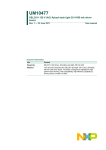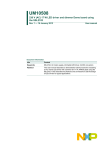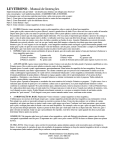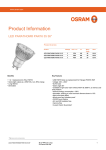Download UM10341_1
Transcript
R A A A A A FT FT FT FT FT D R R A A FT FT FT FT A A R R D D D D R R A FT FT FT A A R R D D D R A F FT FT A A R R D D User manual D Rev. 00.01 — 28 April 2009 R R R R SSL2101/2102 12 W mains dimmable LED driver D D D D D UM10341_1 D FT FT A A R R D D D R A FT D R A Document information Info Content Keywords dimmable, SSL2101, SSL2102, SSL1523, driver, Mains supply, AC/DC conversion, LED driver, User manual Abstract This document is a user manual for the SSL2101/SSL2102 mains dimmable 12 W LED driver demo boards. D D D D D R R R R R A A A UM10341_1 A A FT FT FT FT FT D R R A A A A R R D D D NXP Semiconductors R D R F FT A A D R A A R FT FT First draft D <tbd> FT 01 A Description FT R R Date A D D Rev D R FT FT A A R R D D D Revision history FT FT FT FT SSL2101/SSL2102 12 W LED driver D D R A FT D R A Contact information For more information, please visit: http://www.nxp.com For sales office addresses, please send an email to: [email protected] UM10431_1 User manual © NXP B.V. 2009. All rights reserved. Rev. 00.01 — 28 April 2009 2 of 24 D D D D D R R R R R A A A UM10341_1 A A FT FT FT FT FT D R R A A A A R R D D D NXP Semiconductors D R R A FT FT FT A A R R D D D R A F FT FT A A R R D D D 1. Introduction FT FT FT FT SSL2101/SSL2102 12 W LED driver D FT FT A A R R D The SSL2101/2102 12 W LED driver is a solution for a professional application with multiple high power LEDs that requires galvanic isolation and a safe output voltage. It is mains dimmable for both forward phase (TRIAC) dimmers, and reverse phase (Transistor) dimmers. It can generate up to 16 W output power, which is equal to a 100 W incandescent lamp (at 63 Lumen/W). Examples are shelf lighting, down lighting, LED lighting for bathrooms etc.The design gives an example of how to make a drive that is suitable for small form factor applications like retrofit lamps. D D R A Variac isolation symbols 3. Connecting the board The board can be optimized for a 230 V (AC) (50 Hz) or for a 120 V (AC) (60 Hz) mains source. Besides the mains voltage optimization, the board is designed to work with multiple high power LEDs with a total working voltage of between 9 V and 23 V. The output current can be limited using trimmer R20. On request, a dedicated LED load can be delivered that is to be connected to K3. Connector K2 can be used to attach other LED loads. The output voltage is limited to 25 V. When attaching a LED load to an operational board (hot plugging) an inrush peak current will occur due to discharge of capacitor C6. After frequent discharges, the LEDs may deteriorate or become damaged. Contact information For more information, please visit: http://www.nxp.com For sales office addresses, please send an email to: [email protected] UM10431_1 User manual © NXP B.V. 2009. All rights reserved. Rev. 00.01 — 28 April 2009 3 of 24 A Fig 1. b. Not Isolated R a. Isolated D The board needs to be connected to mains voltage. Touching the reference board during operation must be avoided at all times. An isolated housing is obligatory when used in uncontrolled, non laboratory environments. Even though the secondary circuit with LED connection has a galvanic isolation, this isolation is not according to any regulated norm. Galvanic isolation of the mains phase using a variable transformer is always recommended. These devices can be recognized by the symbols shown in Figure 1: FT 2. Safety warning D D D D D R R R R R A A A UM10341_1 A A FT FT FT FT FT D R R A A A A R R D D D NXP Semiconductors FT FT FT FT SSL2101/SSL2102 12 W LED driver D R R A FT FT FT A A R R D D D R A F FT FT A A R R D D D D FT FT A A R R D D D R A FT D R A Fig 2. Board connection diagram If a galvanic isolated transformer is used, it should be placed in between the AC source and the dimmer/demo board. Connect a user defined LED (string) to the connector K2 as shown in Figure 2. Note that the anode of the LED (string) is connected to the bottom side of this connector. Remark: When the board is placed in a metal enclosure, the middle pin of connector P1 can be connected to the metal casing for grounding. 4. Specifications Table 1 gives the specifications for the SSL2101/2102 12 W LED driver Table 1. Specifications Comment AC line input voltage 85 V (AC) to 276 V (AC) Board has been optimized for 230 V (AC) or 120 V (AC) ± 10 % variation Output voltage (LED voltage) 9 V (DC) to 23 V (DC) Output voltage protection 25 V (DC) Output current (LED current) 400 mA to 800 mA Output voltage /load current dependency <+-4 % / Volt in regulated range See attached graphs Current ripple +/-150 mA at 500 mA Maximum output power (LED power) 17 W At Vout + 21 V Efficiency 70 %-78 % At tamb= 25°C Adjustable with trimmer See attached graphs UM10431_1 User manual © NXP B.V. 2009. All rights reserved. Rev. 00.01 — 28 April 2009 4 of 24 D D D D D R R R R R A A A UM10341_1 A A FT FT FT FT FT D R R A A A A R R D D D NXP Semiconductors D FT FT D R A © NXP B.V. 2009. All rights reserved. Rev. 00.01 — 28 April 2009 D A Demo board (top) User manual F A R Between primary and secondary circuit 5. Board photos UM10431_1 A R D LxWxH +3/ −3 % in the range of 250 V (AC) to 210 V (AC) Fig 3. R R D +5/ −6 % in the range of 130 V (AC) to 110 V (AC) FT Input voltage /load current FT +/-4 KV A 0 to 85 ° Celsius Isolation voltage A Operating temperature R 103mm x 50mm x 20mm D Board dimensions FT 100% – 0% A Dimming range at 15 W output power at 15 W output power at 11 W output power D R R 60-75 kHz FT D D Switching frequency dependency FT FT 230 V(AC) 0.99 0.94 0.90 A A A Comment Power Factor: 120 V(AC) R R R Specifications D D D Table 1. FT FT FT FT SSL2101/SSL2102 12 W LED driver 5 of 24 D D D D D R R R R R A A A UM10341_1 A A FT FT FT FT FT D R R A A A A R R D D D NXP Semiconductors FT FT FT FT SSL2101/SSL2102 12 W LED driver D R R A FT FT FT A A R R D D D R A F FT FT A A R R D D D D FT FT A A R R D D D R A FT D R A Fig 4. Demo board (bottom) 6. Dimmers Several TRIAC based dimmers have been tested by NXP Semiconductors. As different dimmers have different specifications, the dimming performance of the board may vary. Table 2 shows the range of dimmers that have been tested with the board: Table 2. Dimmer selection Manufacturer Type Voltage V (AC) Power range (W) Load Min. dimming range Opus 852.390 230 60-400 Ha/Inc 0.6% Opus 852.392 230 20-500 Inc 0.05% Bush-Jaeger 2250U 230 20-600 Ha/Inc 0.03% Bush-Jaeger 2247U 230 20-500 Ha/Inc 0.07% Bush-Jaeger 6519U 230 40-550 Ha/Inc 8.4% Gira 1184 230 60-400 Inc 1% Everflourish EFO700D 230 50-300 Ha/Inc 0.2% Drespa 0817 230 20-315 Ha/Inc 3.4% Ehmann 39 Domus 230 20-500 Ha/Inc 1% Drespa 815 230 20-500 Inc 1.1% Lutron TG-600PH-W H 120 600 Inc 0 %(off) Levitron L12-6641-W 120 600 Inc 0 %(off) Levitron L02-700-W 120 600 Inc 0 %(off) Levitron 6602-IW 120 600 Inc 0 %(off) Levitron 6683-W 120 600 Inc 0 %(off) UM10431_1 User manual © NXP B.V. 2009. All rights reserved. Rev. 00.01 — 28 April 2009 6 of 24 D D D D D R R R R R A A A UM10341_1 A A FT FT FT FT FT D R R A A A A R R D D D NXP Semiconductors D FT R Power range (W) Load Min. dimming range Levitron R12-6631-LW 120 600 Inc 0 %(off) Cooper 6001 120 600 Inc 0 %(off) Lutron MIR-600THW- 120 WH 600 Ha/Inc 0.9 % D FT FT A A R R D R A FT D R A The board can be equipped with either the SSL2101 or SSL2102, depending on the operating conditions and output power. The SSL2102 has lower thermal resistance and is thus more suitable for higher temperatures and higher loads. The IC has several internal functions. It controls and drives the flyback converter part, and it ensures proper dimmer operation. In the IC itself, there are several high voltage switches integrated. One of these switches controls the flyback input power, and it is situated between the Drain pin and Source pin. On closing, a current will start to run, which stores energy in the transformer TX1. This current is interrupted when the duty factor has exceeded the level set by the PWMLimit pin, with a maximum of 75 %, or when the voltage on the Source pin exceeds 0.5 V. At the next cycle, the energy stored in the transformer is discharged to D6 and the output capacitors C5 and C6, and finally absorbed by the load. The converter frequency is set with an internal oscillator, the timing of which is controlled by external RC components on pins RC and RC2. The frequency can be modulated using the brightness pin to an upper and lower value. The ratio between R15 and R16 sets the frequency variation. © NXP B.V. 2009. All rights reserved. Rev. 00.01 — 28 April 2009 D D 7. Functional description User manual F FT FT Voltage V (AC) A A A R R D D D Manufacturer Type UM10431_1 R A FT FT A A R R R Dimmer selection D D D Table 2. FT FT FT FT SSL2101/SSL2102 12 W LED driver 7 of 24 D D D D D R R R R R A A A UM10341_1 A A FT FT FT FT FT D R R A A A A R R D D D NXP Semiconductors FT D A F FT FT A A R R R WBLEED R A D D SBLEED D R FT FT A A R R D D D ISENSE FT FT FT FT SSL2101/SSL2102 12 W LED driver D FT 1 FT A A R R D 10 2 D D R A DRAIN R 16 SUPPLY D A VCC FT BLEEDER 3 VALLEY 11 GND LOGIC 4, 5,13, 14, 15 AUX 100 mV Stop RC 8 OSCILLATOR 12 Low freq SOURCE Blank THERMAL SHUTDOWN BRIGHTNESS RC2 POWER - UP RESET 6 7 PROTECTION LOGIC FRC Overcurrent PWMLIMIT 9 0.5 V PWM LIMIT CIRCUIT 1.5 V Short-winding protection 014aaa567 Fig 5. Block diagram SSL2101 The two other switches are called the weak-bleeder (pin Wbleed), and the strong bleeder (pin Sbleed). When the voltage on both these pins is below a certain value (typical 52 V) the Sbleed switch closes, providing a current path that loads the dimmer during zero voltage crossing. This resets the dimmer timer. When the voltage on both these pins is above 52 V, and the voltage on the Isens pin is above 100 mV, the weak-bleeder switch closes. Using Q3, this current is boosted and provides a current path that loads the dimmer when the converter draws insufficient current to have the dimmer latching stable. Whilst the strong bleeder is always enabled, the weak-bleeder will activate only when the output power drops below 8 W. This happens when the LEDs are dimmed, or when the maximum LED power is tuned below 8 W. See Figure 6 and Figure 7 that show bleeder voltage versus time in dimmed and un-dimmed position (low voltage = active): UM10431_1 User manual © NXP B.V. 2009. All rights reserved. Rev. 00.01 — 28 April 2009 8 of 24 D D D D D R R R R R A A A UM10341_1 A A FT FT FT FT FT D R R A A A A R R D D D NXP Semiconductors FT FT FT FT SSL2101/SSL2102 12 W LED driver D R R A FT FT FT A A R R D D D R A F FT FT A A R R D D D D FT FT A A R R D D D R A FT D R A Fig 6. Dimmed bleeder operation Fig 7. Un-dimmed bleeder operation This board is optimized to work with a power factor above 0.9. In order to achieve this, the converter operates at constant ton mode. The output power of the converter is buffered by capacitor C6. Due to this configuration, the circuit has a resistive input current behaviour in un-dimmed operation (see Input in Figure 7). In dimmed operation however, not only the dimmer latch and hold current must be maintained, but a damper must be added to dampen the inrush current and to dissipate the electric power that was stored in the LC filter within the dimmer. Though at low power ranges (<10 W) a serial resistor can be used for this, at higher power ranges a single series resistor is not efficient because the converter supply current will cause significant voltage drop and thus dissipation through UM10431_1 User manual © NXP B.V. 2009. All rights reserved. Rev. 00.01 — 28 April 2009 9 of 24 D D D D D R R R R R A A A UM10341_1 A A FT FT FT FT FT D R R A A A A R R D D D NXP Semiconductors FT FT FT FT SSL2101/SSL2102 12 W LED driver D R R A FT FT FT A A R R D D D D R A F FT FT A A R R D D this resistor. On the demonstration board, a combination of serial resistance and a parallel damper has been chosen to improve efficiency. The serial resistor is made up of F1, R1, R2 and R12. The parallel damper is made of C2 and R3. See Figure 8. D FT FT A A R R D D D The input circuit of the converter must be equipped with a filter that is partially capacitive. The combination of C1, L1, L2, C3 and C4 makes a filter that blocks most of the disturbance generated by the converter input current. A drawback of this filter is a reduction of power factor, due to the capacitive load. A lower converter power in relation to the capacitive value of this filter/buffer will cause a lower power factor. At the 230 V (AC) design using 150 nF capacitors, a power factor of 0.9 is reached at 11 W output power. R A 8.1 Changing the output voltage and LED current One of the major advantages of a flyback converter over other topologies, is that it is suitable for driving other output voltages. Essentiality, changing the winding ratio whilst maintaining the value of the primary inductance, will shift the output working voltage accordingly. Part of the efficiency of the driver is linked to the output voltage. A lower output voltage will increase the transformation ratio, and cause higher secondary losses. In practice, a mains dimmable flyback converter will have an efficiency between 80 % for high output voltages (like 60 V) down to 50 % for low output voltages (like 3 V). At low voltages, synchronous rectification might become advisable to reduce losses. The NXP TEA1791 can be applied for this purpose. For exact calculations of transformer properties and peak current, we refer to application note AN10754_1, “How to design an LED driver using the SSL2101”, and the excel spreadsheet that goes with it. 8.2 Changing the output ripple current The output current ripple is mostly determined by the LED voltage, the LED dynamic resistance and the output capacitor. Whilst the value of C6 has been chosen to optimize capacitor size with light output. A ripple of ± 25 % will result in an expected deterioration of light output <1 %. UM10431_1 User manual © NXP B.V. 2009. All rights reserved. Rev. 00.01 — 28 April 2009 10 of 24 A The following modifications can be done in order to meet different customer application requirements: R 8. Board optimization D The dimming range is detected by sensing the average rectified voltage. R4, R5 and R17 make a voltage divider, and C9 filters the resulting signal. The converter sets its duty factor and converter frequency accordingly. FT The board is equipped with a feedback loop that limits the output current. This feedback loop senses the LED current over sense resistor R18, and a current mirror is made of Q1/Q2. Using R20, the current level can be set. The same feedback loop is also used for overvoltage protection. If the LED voltage exceeds 23 V, a current through R19 and D9 will start running. The current through the opto coupler IC2 will pull down the PWM_Limit and brightness pin. At a value below 400 mV, the on time is zero. The feedback loop has proportional action only, and the gain is critical because of phase shift caused by the converter and C6. The relation between PWM_Limit and output current is quadratic in nature. The resulting output current spread will be acceptable for most LED applications. D D D D D R R R R R A A A UM10341_1 A A FT FT FT FT FT D R R A A A A R R D D D NXP Semiconductors D R R A FT FT FT A A R R D D D R A F FT FT A A R R D D D D D FT FT A A R R The size for the buffer capacitor can be estimated from the following equation I 1 C 6 = ----- ⋅ ----------------------------------------ΔI 6 ⋅ f net ⋅ R dynamic FT FT FT FT SSL2101/SSL2102 12 W LED driver D D As example: For a ripple current of ± 5%, and a mains frequency of 50 Hz, and a dynamic resistance of 0.6 Ω, C6 becomes 20/(300*0.6) = 111 mF. For a ripple current of 25 % and a dynamic resistance of 6 Ω, 4/(300*6) = 2200 μF. Using a series of LEDs, the dynamic resistance of each LED can be added to the total dynamic resistance. R A • Transistor dimmers contain active circuitry that require a load charge during the time that the dimmer is open. The dimensioning of the circuit generating the internal supply voltage inside the dimmer is made critical in order to avoid excessive internal dimmer losses. This means that the remaining voltage drop over the lamp must be low enough to reach this charge. For dimmers like the Busch-Jaeger 6519U, the minimum lamp load is specified at 40 W which is equivalent to a 1.3 kΩ resistor load at 230 V(AC). Such a load would result in highly inefficient operation at low output power levels, since most energy is waisted in order to drive the dimmer, and not to produce light. On the demo board, the weak bleeder value R6/R7 is choosen is such way, that losses are still acceptable (about 2 W to 3 W) and only occur in dimmed position. The voltage drop with some transistor dimmers is however not sufficient to cause full dimming range control (minimum 10 % instead of <1 %), because at the SSL2101 the dimming range is sensed by taking the average rectified voltage as input. To compensate for the reduced voltage difference, voltage detection can be made more sensitive by replacing R4 with a Zener diode, like the BZV85-C200 for 230 V(AC), or the BZV85-C68 for 120 V (AC) applications. Because of increased sensitivity, the dimming curve when using TRIAC dimmers, will also be steeper and shifted. 8.4 Changing the load curve The load curve can be divided into two regions: A part where the control loop limits the duty cycle of the converter, and where the output current is regulated, and a part where the duty factor feedback is not dominant anymore. This last part occurs at output voltages below 13 V. In this area, constant output power becomes the dominant control mechanism. Changing the winding ratio of the transformer to match the output load will also change this load curve. UM10431_1 User manual © NXP B.V. 2009. All rights reserved. Rev. 00.01 — 28 April 2009 11 of 24 A dimmers, there will be a sudden voltage difference over the input leading to a steep charge of the input capacitors. The resulting peak current will lead to higher damper dissipation. Because this steep charge is missing, the input capacitors will have less stress, and the input circuit is less prune to audible noise. R • The negative phase causes no inrush current when the dimmer triggers. At TRIAC D Reverse phase (transistor) dimmers differ in two ways that can be beneficial but can also cause problems with dimming detection: FT 8.3 Adapting to high power reverse phase (transistor) dimmers. D D D D D R R R R R A A A UM10341_1 A A FT FT FT FT FT D R R A A A A R R D D D NXP Semiconductors D R R A FT FT FT A A R R D D D R A FT FT A A R R D D It is possible to attach multiple converters to a single dimmer. At the use of TRIAC dimmers the inrush current will rise, though not proportionally to the number of converters. Transistor dimmers are more suitable for usage with multiple converters because the dimming range will increase due to the added bleeder action, and there is no inrush current. F FT FT A A R R D D D 8.5 Multiple driver support FT FT FT FT SSL2101/SSL2102 12 W LED driver D D R A FT D R A UM10431_1 User manual © NXP B.V. 2009. All rights reserved. Rev. 00.01 — 28 April 2009 12 of 24 D D D D D R R R R R A A A UM10341_1 A A FT FT FT FT FT D R R A A A A R R D D D NXP Semiconductors D R R A FT FT FT A A R R D D D R A F FT FT A A R R D D D 9. Board schematic FT FT FT FT SSL2101/SSL2102 12 W LED driver D FT FT A A R R D D D R A FT D R A Fig 8. Board schematic diagram UM10431_1 User manual © NXP B.V. 2009. All rights reserved. Rev. 00.01 — 28 April 2009 13 of 24 D D D D D R R R R R A A A UM10341_1 A A FT FT FT FT FT D R R A A A A R R D D D NXP Semiconductors FT F A Package Manuf. Amount Conn 3pin 2u ang m SL 5.08/3/90 Weidmuller 1 K1' Conn 3pin 2u f BL 5.08/3 Weidmuller 1 3 K3 Conn 6pin 1u f BL3.36Z Fischer 4 K2 Conn 2pin 2u ang m SL 5.08/2/90 Weidmuller 1 5 K2' Conn 2pin 2u f BL 5.08/2 Weidmuller 1 6 F1 Fusistor 6.8E 1W 10 % Free 1 7 R1 Resistor 39 Ω 1W 5% Free 1 8 R2 Resistor 39 Ω 1W 5% Free 1 9 R3 Resistor 1 KΩ 2W 5% Free 1 10 R4 Resistor 470 KΩ 0.25 1% Free 1 11 R5 Resistor 470 KΩ 0.25 1% Free 1 12 R6 Resistor 10 KΩ 1W 5% 200 Free 1 13 R7 Resistor 10 KΩ 1W 5% 200 Free 1 14 R8 Resistor 2.2 KΩ 1W 5% 200 Free 1 15 R9 Resistor 2.2KΩ2 1W 5% 200 Free 1 D Volt FT Tol. D Pwr FT Type R A FT A Resistor 0.4 Ω 1W 1% Free 1 R11 Resistor 33 KΩ 0.25 5% 200 Free 1 18 R12 Resistor 15 Ω 1W 5% 200 Free 1 19 R13 Resistor 100 KΩ 0.1 1% 200 Free 1 20 R14 Resistor 22 KΩ 0.1 1% Free 1 21 R15 Resistor 470K 0.1 1% Free 1 22 R16 Resistor 4.7 KΩ 0.1 1% Free 1 23 R17 Resistor 12 KΩ 0.1 1% Free 1 24 R18 Resistor 0.3 Ω 1W 1% Free 1 25 R19 Resistor 10 KΩ 0.1 5% Free 1 26 R20 Resistor 50 KΩ Lin 0.1 5% Horizontal 27 R21 Resistor 22 KΩ 0.1 1% Free 1 28 R22 Resistor 330 Ω 0.1 1% Free 1 29 R23 Resistor 470 Ω 0.25 5% Free 1 30 R24 Resistor 3.9 KΩ 0.1 5% Free 1 31 R25 Resistor 470 KΩ 0.25 5% Free 1 32 R26 Resistor 10 KΩ 0.1 5% Free 1 33 C1 Capacitor 470 pF Cer 10 % 1K DEBB33A471KC1B Murata 1 34 C2 Capacitor 150 nF Poly 10 % 400 NRM-S154K400F NIC 1 35 C3 Capacitor 150 nF Poly 10 % 400 NRM-S154K400F NIC 1 36 C4 Capacitor 150 nF Poly 10 % 400 NRM-S154K400F NIC 1 37 C5 Capacitor 4.7μF Poly 10 % 63 B32560J475K Epcos 1 UM10431_1 R R10 17 Bourns D 1 16 User manual R A 2 R K1 D D 1 Value A FT FT Part R A A Par Ref. t Des. No. D R R Bill of materials 230 V (AC) R A D D Table 3. D R FT FT A A R R D D D 10. Bill of materials (BOM) FT FT FT FT SSL2101/SSL2102 12 W LED driver 1 © NXP B.V. 2009. All rights reserved. Rev. 00.01 — 28 April 2009 14 of 24 D D D D D R R R R R A A A UM10341_1 A A FT FT FT FT FT D R R A A A A R R D D D NXP Semiconductors D R A F R 330 pF Cer 41 C9 Capacitor 10 μF 105° 10 % 42 C10 Capacitor 2.2 nF Cer 10 % 4K 43 C11 Capacitor 10 nF Cer 10 % 25 44 L1 Inductor 680 μH 744776268 Wurth 1 45 L2 Inductor 330 μH 744776233 Wurth 1 46 L3 Inductor 100 μH 47 TX1 Transformer N87/3F3 48 D1 Rect Bridge 2A 49 D2 TVS diode 600 W 50 D3 Diode 1A 800 V 51 D4 Zener 270 V 3W 52 D5 Diode 53 D6 54 5% 25 Free 1 Free 1 DECE33J222ZC4B Murata Free 1 1 74477120 Wurth 1 EFD25 750340505 Wurth 1 SO-4 DBLS205G Taiwan semi 1 P6KE400A Fairchild 1 HER107 Taiwan semi 1 BZT03-C220 Vishay 1 1A 800 V HER107 Taiwan semi 1 Diode 3A 100 V SK310A Taiwan semi 1 D7 Diode 1A 800 V HER107 Taiwan semi 1 55 D8 Zener 30 V 5% BZV55-C30 NXP 1 56 D9 Zener 20 V 5% BZV55-C20 NXP 1 57 D10 Diode 75 V 1N4148 NXP 1 58 Q1 Transistor NPN BC847B NXP 1 59 Q2 Transistor NPN BC847B NXP 1 60 Q3 Transistor PNP ZTX758 Zetex 1 61 ISO2 Optocoupler 4N27 Vishay 1 62 U1 IC 5% SSL2101 SSL2102 SO-1 6SO20 W Y SSL2101/ SSL2102 Tol. Volt Package A Capacitor R C8 1 D 40 1 Free 1 Bill of materials 120 V (AC) Part Ref. No. Des. Part Value 1 K1 Conn 3pin 2u ang 2 K1' 3 K3 Pwr Type Manuf. Amount m SL 5.08/3/90 Weidmuller 1 Conn 3pin 2u f BL 5.08/3 Weidmuller 1 Conn 6pin 1u f BL3.36Z Fischer 1 UM10431_1 User manual © NXP B.V. 2009. All rights reserved. Rev. 00.01 — 28 April 2009 D 25 FT 25 105° 10 % A 105° 10 % 4.7 μF R 2200 μF Capacitor D Capacitor C7 FT C6 39 FT A A R 38 Table 4. D Vishay Amount FT 2222 021 16222 A Manuf. D Type FT Package A Volt R R R Tol. D D D Pwr FT FT FT Value A A A Part R R R Bill of materials 230 V (AC) Par Ref. t Des. No. D D D Table 3. FT FT FT FT SSL2101/SSL2102 12 W LED driver 15 of 24 D D D D D R R R R R A A A UM10341_1 A A FT FT FT FT FT D R R A A A A R R D D D NXP Semiconductors D R R Amount Weidmuller 1 Conn 2pin 2u f BL 5.08/2 Weidmuller 1 F1 Fusistor 6.8E 1W 10 % Free 1 7 R1 Resistor 27 Ω 1W 5% Free 1 8 R2 Resistor 27 Ω 1W 5% Free 1 9 R3 Resistor 2.7 KΩ 1W 5% Free 1 10 R4 Resistor 470 KΩ 0.25 1% Free 1 11 R5 Resistor 0Ω 0.25 5% Free 1 12 R6 Resistor 2.7 KΩ 1W 5% 200 Free 1 13 R7 Resistor 2.7 KΩ 1W 5% 200 Free 1 14 R8 Resistor 1 KΩ 1W 5% 200 Free 1 15 R9 Resistor 1 KΩ 1W 5% 200 Free 1 16 R10 Resistor 0.4 Ω 1W 1% Free 1 17 R11 Resistor 33 KΩ 0.25 5% 200 Free 1 18 R12 Resistor 10 Ω 1W 5% 200 Free 1 19 R13 Resistor 100 KΩ 0.1 1% 200 Free 1 D R FT FT A A R D D SL 5.08/2/90 F m A Manuf. FT Type R 1% Free 1 0.1 1% Free 1 22 R16 Resistor 10 KΩ 0.1 1% Free 1 23 R17 Resistor 12 KΩ 0.1 1% Free 1 24 R18 Resistor 0.3 Ω 1W 1% Free 1 25 R19 Resistor 10 KΩ 0.1 5% Free 1 26 R20 Resistor 50 KΩ Lin 0.1 5% Horizontal Bourns 1 27 R21 Resistor 22 KΩ 0.1 1% Free 1 28 R22 Resistor 330 Ω 0.1 1% Free 1 29 R23 Resistor 3.9 KΩ 0.25 5% Free 1 30 R24 Resistor 3.9 KΩ 0.1 5% Free 1 0.25 5% Free 1 Free 1 31 R25 Resistor 100 KΩ 32 R26 Resistor NP 33 C1 Capacitor 470 pF Cer 10 % 1 KV DEBB33A471KC1B Murata 1 34 C2 Capacitor 100 nF Poly 10 % 400 NRM-S104K400F NIC 1 35 C3 Capacitor 330 nF Poly 10 % 400 NRM-S334K400F NIC 1 36 C4 Capacitor 330 nF Poly 10 % 400 NRM-S334K400F NIC 1 37 C5 Capacitor 4.7 μF Poly 10 % 63 B32560J475K Epcos 1 38 C6 Capacitor 2200 μF 105° 10 % 25 2222 021 16222 Vishay 1 39 C7 Capacitor 4.7 μF 105° 10 % 25 40 C8 Capacitor 330 pF Cer 5% 41 C9 Capacitor 10 μF 105° 10 % 25 42 C10 Capacitor 2.2 nF Cer 10 % 4K Free 1 Free 1 Free 1 UM10431_1 DECE33J222ZC4B Murata A 0.1 470 KΩ R 15 KΩ Resistor D Resistor R15 FT R14 21 A 20 User manual D A Package FT R Volt D 6 D K2' Tol. FT 5 Pwr A Conn 2pin 2u ang R K2 D 4 FT FT Value A A A Part R R R Bill of materials 120 V (AC) Part Ref. No. Des. D D D Table 4. FT FT FT FT SSL2101/SSL2102 12 W LED driver 1 © NXP B.V. 2009. All rights reserved. Rev. 00.01 — 28 April 2009 16 of 24 D D D D D R R R R R A A A UM10341_1 A A FT FT FT FT FT D R R A A A A R R D D D NXP Semiconductors D R Volt Package Amount 43 C11 Capacitor 10 nF Cer 10 % 25 Free 44 L1 Inductor 680 μH 744776268 Wurth 1 45 L2 Inductor 330 μH 744776233 Wurth 1 46 L3 Inductor 100 μH 74477120 Wurth 1 47 TX1 Transformer N87/3F3 EFD25 750340505 Wurth 1 48 D1 Rect Bridge 2A SO-4 DBLS205G Taiwan semi 1 49 D2 TVS diode 600 W P6KE270A Fairchild 50 D3 Diode 1 A 800 V HER107 Taiwan semi 1 51 D4 Zener 270 V 3W BZT03-C220 Vishay 52 D5 Diode 1 A 800 V HER107 Taiwan semi 1 53 D6 Diode 3 A 100 V SK310A Taiwan semi 1 54 D7 Diode 1 A 800 V HER107 Taiwan semi 1 55 D8 Zener 30 V 5% BZV55-C30 NXP 1 56 D9 Zener 20 V 5% BZV55-C20 NXP 1 57 D10 Diode 75 V 1N4148 NXP 1 58 Q1 Transistor NPN BC847B NXP 1 D FT FT D R A BC847B NXP 1 PNP MPSA92 NXP 1 61 ISO2 Optocoupler 4N27 Vishay 1 62 U1 IC SSL2102 A NPN SSL2101/ R Transistor Transistor SO-20 W D Q2 Q3 SO-16 Y FT 1 60 SSL2102 A 1 59 SSL2101 A R R D 1 1 11. Transformer specification Figure 9 shows the transformer schematic: 1 9 N1 2 N3 6 4 N2 5 Fig 9. Transformer schematic UM10431_1 User manual © NXP B.V. 2009. All rights reserved. Rev. 00.01 — 28 April 2009 D Tol. F Pwr FT Value FT Part A A A Part Ref. No. Des. 5% R D R R Manuf. FT D D Type A FT FT A A R R R Bill of materials 120 V (AC) D D D Table 4. FT FT FT FT SSL2101/SSL2102 12 W LED driver 17 of 24 D D D D D R R R R R A A A UM10341_1 A A FT FT FT FT FT D R R A A A A R R D D D NXP Semiconductors FT N1 1X0.315 8 ISO 0.2 1 21 9 6 1 42 5 4 1 42 A 7 2 R 0.2 43 D 1X0.2 ISO 1 11.2 Electrical characteristics Table 6. Inductance Section Inductance N1 910 μH ± 5 %, at 2.3 A N2 70 μH N3 270 μH • Nominal frequency = 100 kHz • Vbreakdown N1...N2 = 4 KV 11.3 Core and bobbin • Core: EFD25, 3F3/N87, airgap center 1100 μM • Bobbin: CSH-EFD25-1S-10P UM10431_1 User manual D N2 6 F 5 A 0.2 1 FT ISO FT 4 A 40X0.071 A N3 R 3 R 0.2 End D 1X0.315 ISO FT Pin A Turns R N1 2 D D Layers Begin 1 FT FT Wire R A A Section D R R No. Winding specification R A D D Table 5. D R FT FT A A R R D D D 11.1 Winding specification FT FT FT FT SSL2101/SSL2102 12 W LED driver © NXP B.V. 2009. All rights reserved. Rev. 00.01 — 28 April 2009 18 of 24 D D D D D R R R R R A A A UM10341_1 A A FT FT FT FT FT D R R A A A A R R D D D NXP Semiconductors D R R A FT FT FT A A R R D D D R A F FT FT A A R R D D D 11.4 Physical dimensions FT FT FT FT SSL2101/SSL2102 12 W LED driver D FT FT A A R R D D D R A FT D R A Fig 10. Transformer dimensions 12. Appendix A - Load curves 120 V (AC) load curves 1.200 500 mA 800 mA 650 mA 1.100 1.000 Iout 0.900 0.800 0.700 0.600 0.500 0.400 6 8 10 12 Uload 14 16 18 20 22 Fig 11. 120 V (AC) load curve UM10431_1 User manual © NXP B.V. 2009. All rights reserved. Rev. 00.01 — 28 April 2009 19 of 24 D D D D D R R R R R A A A UM10341_1 A A FT FT FT FT FT D R R A A A A R R D D D NXP Semiconductors D R R A FT FT FT A A R R D D D R A F FT FT A A R R D D D D D R A 1 .200 D FT 500 mA 800 mA 700 mA FT 1 .300 FT A A R R D 230 V (AC) load curves FT FT FT FT SSL2101/SSL2102 12 W LED driver D R 1 .100 A 1 .000 Iout 0 .900 0 .800 0 .700 0 .600 0 .500 0 .400 9 11 13 15 Uload 17 19 21 23 Fig 12. 230 V (AC) load curve 13. Appendix B - Efficiency curves 500 mA 800 mA 650 mA 120 V (AC) efficiency curves 80.0 % 75.0 % n 70.0 % 65.0 % 60.0 % 55.0 % 6 8 10 12 Uload 14 16 18 20 22 Fig 13. 120 V (AC) efficiency curve UM10431_1 User manual © NXP B.V. 2009. All rights reserved. Rev. 00.01 — 28 April 2009 20 of 24 D D D D D R R R R R A A A UM10341_1 A A FT FT FT FT FT D R R A A A A R R D D D NXP Semiconductors D R R A FT FT FT A A R R D D D R A F FT FT A A R R D D D D FT D D R A FT 500 mA 800 mA 700 mA FT A A R R D 230 V (AC) efficiency curves 80 .0% FT FT FT FT SSL2101/SSL2102 12 W LED driver D R 75 .0% A n 70 .0% 65 .0% 60 .0% 55 .0% 9 11 13 15 17 Uload 19 21 23 Fig 14. 230 V (AC) effeciency curve 14. Appendix C - Input voltage dependency 120 V (AC) input voltage dependency 230 V (AC) input voltage dependency 0.74 0.67 0.66 0.73 0.65 0.72 0.64 0.63 0.71 Iout (A) Iout (A) 0.62 0.61 0.7 0.6 0.69 0.59 0.68 0.58 0.57 0.67 0.56 0.66 0.55 0.54 0.65 0.53 0.52 100 0.64 105 110 115 120 125 130 130 135 200 Vin (V) 205 210 215 220 225 230 235 240 245 250 Vin (V) Fig 15. Input voltage/output current dependency UM10431_1 User manual © NXP B.V. 2009. All rights reserved. Rev. 00.01 — 28 April 2009 21 of 24 D D D D D R R R R R A A A UM10341_1 A A FT FT FT FT FT D R R A A A A R R D D D NXP Semiconductors FT D R 2 0 0 3 13.2 9 4 0 0 5 3.8 2.1 6 0 0.1 7 1.2 1.9 8 0.1 0.1 9 3.2 2 0 0.1 13 2.5 1.3 14 0 0.1 15 1.8 1.2 16 0 0.1 17 2.1 0.5 18 0 0 19 2.9 0.1 20 0 0 THD 15.94 10.80 PF 0.94 0.98 A 12 R 0 D 0.1 0.5 FT 0 11 A 10 [1] AN10754_1 — How to design an LED driver using the SSL2101 [2] SSL2101 — Datasheet [3] SMPS — IC for dimmable LED lighting © NXP B.V. 2009. All rights reserved. Rev. 00.01 — 28 April 2009 D 100 R 100 D 1 FT 120 V (AC) 60Hz Amplitude (%) FT A A R 230 V (AC) 50 Hz Amplitude (%) 16. References User manual F D D Harmonic UM10431_1 A FT FT A A R R R Mains conducted harmonic values R A D D Table 7. D R FT FT A A R R D D D 15. Appendix D - Mains conducted harmonics FT FT FT FT SSL2101/SSL2102 12 W LED driver 22 of 24 D D D D D R R R R R A A A UM10341_1 A A FT FT FT FT FT D R R A A A A R R D D D NXP Semiconductors D A FT R F D FT FT A A R damage. NXP Semiconductors accepts no liability for inclusion and/or use of NXP Semiconductors products in such equipment or applications and therefore such inclusion and/or use is at the customer’s own risk. R D R A 17.4 Patents Right to make changes — NXP Semiconductors reserves the right to make changes to information published in this document, including without limitation specifications and product descriptions, at any time and without notice. This document supersedes and replaces all information supplied prior to the publication hereof. Notice is herewith given that the subject device uses one or more of the following patents and that each of these patents may have corresponding patents in other jurisdictions. Suitability for use — NXP Semiconductors products are not designed, authorized or warranted to be suitable for use in medical, military, aircraft, space or life support equipment, nor in applications where failure or malfunction of an NXP Semiconductors product can reasonably be expected to result in personal injury, death or severe property or environmental 17.5 Trademarks <Patent ID> — owned by <Company name> Notice: All referenced brands, product names, service names and trademarks are the property of their respective owners. <Name> — is a trademark of NXP B.V. UM10431_1 © NXP B.V. 2009. All rights reserved. Rev. 00.01 — 28 April 2009 23 of 24 A <License statement text> (replace by text inset t001lic<1nn>) R Purchase of NXP <xxx> components D General — Information in this document is believed to be accurate and reliable. However, NXP Semiconductors does not give any representations or warranties, expressed or implied, as to the accuracy or completeness of such information and shall have no liability for the consequences of use of such information. FT Applications — Applications that are described herein for any of these products are for illustrative purposes only. NXP Semiconductors makes no representation or warranty that such applications will be suitable for the specified use without further testing or modification. 17.3 Licenses 17.2 Disclaimers D D Draft — The document is a draft version only. The content is still under internal review and subject to formal approval, which may result in modifications or additions. NXP Semiconductors does not give any representations or warranties as to the accuracy or completeness of information included herein and shall have no liability for the consequences of use of such information. User manual A FT FT A A R R D D D 17.1 Definitions R R FT FT A A R R D D D 17. Legal information FT FT FT FT SSL2101/SSL2102 12 W LED driver D D D D D R R R R R A A A UM10341_1 A A FT FT FT FT FT D R R A A A A R R D D D NXP Semiconductors FT R F FT FT A A A D FT FT A A R R D D D R A FT D R A 8.4 8.5 9 10 11 11.1 11.2 11.3 11.4 12 13 14 15 16 17 17.1 17.2 17.3 17.4 17.5 18 D R R 8.2 8.3 Introduction . . . . . . . . . . . . . . . . . . . . . . . . . . . . 3 Safety warning . . . . . . . . . . . . . . . . . . . . . . . . . . 3 Connecting the board . . . . . . . . . . . . . . . . . . . . 3 Specifications. . . . . . . . . . . . . . . . . . . . . . . . . . . 4 Board photos . . . . . . . . . . . . . . . . . . . . . . . . . . . 5 Dimmers . . . . . . . . . . . . . . . . . . . . . . . . . . . . . . . 6 Functional description . . . . . . . . . . . . . . . . . . . 7 Board optimization . . . . . . . . . . . . . . . . . . . . . 10 Changing the output voltage and LED current . . . . . . . . . . . . . . . . . . . . . . . . . . . . . . 10 Changing the output ripple current . . . . . . . . . 10 Adapting to high power reverse phase (transistor) dimmers.. . . . . . . . . . . . . . . . . . . . 11 Changing the load curve. . . . . . . . . . . . . . . . . 11 Multiple driver support . . . . . . . . . . . . . . . . . . 12 Board schematic . . . . . . . . . . . . . . . . . . . . . . . 13 Bill of materials (BOM) . . . . . . . . . . . . . . . . . . 14 Transformer specification . . . . . . . . . . . . . . . . 17 Winding specification . . . . . . . . . . . . . . . . . . . 18 Electrical characteristics . . . . . . . . . . . . . . . . . 18 Core and bobbin . . . . . . . . . . . . . . . . . . . . . . . 18 Physical dimensions . . . . . . . . . . . . . . . . . . . . 19 Appendix A - Load curves. . . . . . . . . . . . . . . . 19 Appendix B - Efficiency curves . . . . . . . . . . . 20 Appendix C - Input voltage dependency . . . . 21 Appendix D - Mains conducted harmonics . . 22 References . . . . . . . . . . . . . . . . . . . . . . . . . . . . 22 Legal information. . . . . . . . . . . . . . . . . . . . . . . 23 Definitions . . . . . . . . . . . . . . . . . . . . . . . . . . . . 23 Disclaimers . . . . . . . . . . . . . . . . . . . . . . . . . . . 23 Licenses . . . . . . . . . . . . . . . . . . . . . . . . . . . . . 23 Patents . . . . . . . . . . . . . . . . . . . . . . . . . . . . . . 23 Trademarks. . . . . . . . . . . . . . . . . . . . . . . . . . . 23 Contents . . . . . . . . . . . . . . . . . . . . . . . . . . . . . . 24 R A D D 1 2 3 4 5 6 7 8 8.1 D R FT FT A A R R D D D 18. Contents FT FT FT FT SSL2101/SSL2102 12 W LED driver Please be aware that important notices concerning this document and the product(s) described herein, have been included in section ‘Legal information’. © NXP B.V. 2009. All rights reserved. For more information, please visit: http://www.nxp.com For sales office addresses, please send an email to: [email protected] Date of release: 28 April 2009 Document identifier: UM10431_1


























